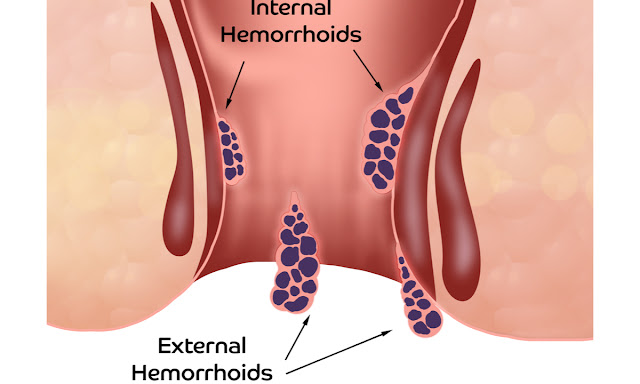Internal vs External Haemorrhoids: What's the Difference?

Internal vs External Haemorrhoids: What's the Difference?
Haemorrhoids, also
called piles, are dilated (swollen) veins located on the walls of the lower
rectum and anus. They occur when the group of pillow-shaped veins that are just
below the mucous membranes that line the lower part of the rectum and the anus,
suffer an uncontrolled vascular tone and move downwards causing
"swelling".
It is something
similar to what happens with varicose veins in the legs. They are classified by
their location, as they can be internal (located in the lower part of the
rectum) or external (originates from the anal opening). If you are looking for
Haemorrhoids Medication, you can buy Proctosedyl Ointment and Scheriproct Online in the UK.
What are external haemorrhoids?
External
haemorrhoids are those that occur around the anus. They are inflamed veins that
can often be seen and felt under the skin outside the anal canal, and they look
like a small, palpable lump and are the same colour as the skin. They are
characterized by being very uncomfortable since the skin that covers them becomes
irritated and eroded.
External
haemorrhoids often accompany internal ones and do not bleed, although they can
cause a sensation of heaviness and anal pain due to a process of thrombosis.
Symptoms of external haemorrhoids:
External
haemorrhoids are characterized by symptoms such as itching or irritation in the
anal area, pain, discomfort or swelling, and bleeding in the stool. These
symptoms can also be due to other conditions. Whatever the reason, it is
important to see a doctor for a correct diagnosis and treatment of
haemorrhoids.
How long do external haemorrhoids last?
Haemorrhoids usually appear episodically and,
many times, remit spontaneously. If the haemorrhoids are mild, the symptoms may
disappear in a few days without the need for medical treatment.
If these episodes
occur more frequently, they end up establishing themselves permanently.
Untreated haemorrhoids tend to grow in size and present greater complications:
pain, itching, bleeding and even difficulty in properly cleaning the area after
defecation.
If they protrude
from the anus, they may take longer to heal, several weeks, and may even
require surgical treatment. In these cases, consulting a health professional is
recommended so that under a good diagnosis, you can implement the correct
treatment.
Thrombosed external haemorrhoids:
If blood collects
in an external haemorrhoid and forms a blood clot (thrombus) it is called a
thrombosed haemorrhoid, and pain can be sudden and severe. Its symptoms are
usually more pronounced and can cause severe pain, swelling, inflammation, and
a lump near the anus that can turn purple or blue.
When the clot
dissolves, it leaves excess skin that can itch or become irritated.
What are the internal haemorrhoids?
Internal
haemorrhoids occur inside the rectum in its lower part. In general, they cannot
be seen or felt, and they rarely cause discomfort.
However, efforts to
evacuate or some type of irritation can cause painless bleeding, can cause a
prolapse extending beyond the anus producing an external protrusion, which
causes pain and irritation.
When a haemorrhoid
protrudes (prolapsed haemorrhoid), it can collect small amounts of mucus and
tiny particles of stool that can cause an irritation called itching of the
anus. Constantly cleaning to try to relieve the itchiness can make the problem
worse.
Symptoms of internal haemorrhoids:
The most
significant symptom of internal haemorrhoids is bleeding during bowel
movements, which appears as bright red or very red blood and is clearly seen on
toilet paper or in drops in the toilet.
Unless accompanied
by a hemorrhoidal thrombosis, they are not painful and are far enough into the
rectum that they cannot be seen. Yes, they can present pain at the time of
bowel movements due to the effort or irritation they cause.
Haemorrhoids and bleeding:
Internal
haemorrhoids are the most likely to produce bleeding, usually painless, that
occurs during bowel movements.
Straining or making
a particularly hard bowel movement can damage the surface of a haemorrhoid,
causing it to bleed. This can happen with external haemorrhoids as well. In
some cases, a thrombosed haemorrhoid can rupture if it has a large blood
content, causing bleeding.



Comments
Post a Comment